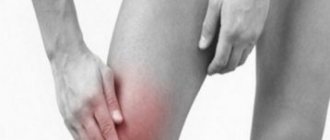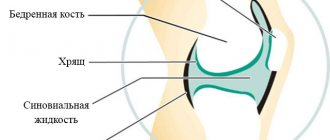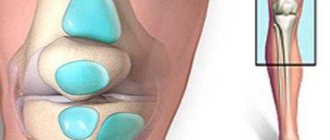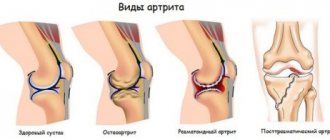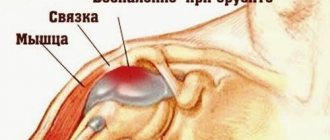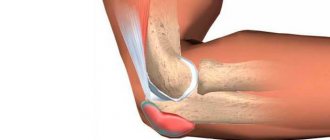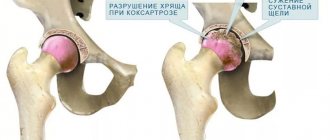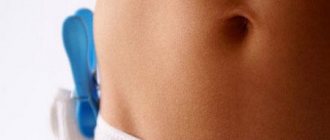The knee is one of the large joints. Its function is quite complex: not only to ensure full range of limb movement, but also to support the weight of the human body, sometimes quite large. Accordingly, a torn meniscus of the knee joint is one of the most common knee injuries.
What is the meniscus and its anatomy
The meniscus is a crescent-shaped cartilage tissue that is necessary to absorb the loads placed on the knee joint. If you pay attention to the structure of the knee joint, you will notice that the joint has 2 types of menisci:
- External (lateral) meniscus;
- Internal (medial) meniscus.
As you can see from the schematic image of the knee joint (in section), the menisci serve as a kind of “lining” between the articular processes of the tibia and femur. Thanks to this “lining”, a lot of friction is not created inside the knee joint, which is accompanied by pain, cracking and clicking in the joint.
When a person moves, the knee joint bends and extends with each step, and the knee meniscus also works in time with each step.
- The lateral (outer) meniscus is very mobile and due to this, its structure is quite dense and strong.
The external meniscus is less susceptible to injury due to excessive loads on the joint, unlike the medial one. The lateral meniscus in appearance resembles a wide “crescent”, which can sometimes reach an almost ring-shaped shape. It is attached: - At the tibia, connecting to it at two points located in the middle part;
- In the synovial capsule, the attachment appears in the form of thin bundles that extend from the tendons of the popliteus muscle. Thanks to this particular connection, the lateral meniscus has its mobility.
At the condyle of the femur, with the help of two meniscofemoral ligaments;
- The medial (internal) meniscus, unlike the lateral one, has a narrower shape and smaller size.
Its range of movement is much lower, making it more susceptible to injury. The anterior horn of the internal meniscus is attached to the medial part of the intercondylar eminence, immediately above the anterior cruciate ligament (ACL), and the posterior horn is connected to the lateral part of the intercondylar eminence, at the base of the posterior cruciate ligament (PCL) and posterior to the attachment of the external meniscus.
About the reasons
Athletes, dancers, and people doing heavy physical labor are especially susceptible to this type of injury.
Due to the nature of their work, they have to deal with increased stress on their knees. Mostly people of working age and pensioners seek medical help. Children and adolescents under 14 years of age rarely suffer from this problem due to the elasticity of cartilage tissue. All causes of meniscus tear are divided into two groups:
- traumatic injuries;
- degenerative damage.
Young people experience injuries due to indirect or combined injuries.
Provoking factors are:
Meniscus tear
- forced extension movements;
- increased load on the knee;
- long-term static position of the joint;
- unnatural movements in the form of torsion, walking on toes, goose steps;
- ligament weakness;
- direct injury due to a fall or blow to the knee.
In this case, damage to the medial meniscus occurs during extension actions, and rupture of the external meniscus occurs during internal rotation of the tibia.
Older patients are characterized by chronic and degenerative tears of the medial meniscus.
One of the main reasons why the meniscus ruptures in the knee joint is a combined injury. Most often it occurs due to rotation of the tibia inward (for the lateral meniscus) or outward (for the medial).
Another reason for a meniscus tear is sudden extension of the leg from a bent position or impact of the knee on a hard surface. Repeated trauma can cause a chronic disease such as arthrosis, gout, or even the formation of cysts.
Repeated rupture of the meniscus can provoke a huge number of degenerative changes with similar symptoms. Diagnosis of such diseases is carried out exclusively by a specialist (examination, X-ray, CT, arthroscopy).
The consequences of untreated damage to the meniscus can be not only diseases of the tendons and cartilage, but also changes in the structure of the joint.
Main causes of meniscus tear
Meniscus injuries are one of the most common injuries among dancers, football players, and weightlifters. It is this group of people who are susceptible to receiving a sudden, short-term large load on the joint, which the meniscus is able to withstand.
But the risk group for meniscal tears may also include:
- People whose work process does not exclude variable physical loads on the knee joint;
- A group of people who already have or have had musculoskeletal diseases;
- Overweight people experience even low external loads on the knee joint.
Rehabilitation
With the right treatment, the knee joint is almost completely restored, but for several months the patient is advised to limit movements and physical activity. In addition, it is necessary to unconditionally follow all medical instructions.
If the meniscus has been completely removed, it will take 1-2 weeks to develop the leg and walk with crutches; with partial resection, this period increases slightly.
For people whose meniscus tears occur during the natural work of the lower limb, loads should be limited for 1-2 months.
Want to get the same treatment, ask us how?
Types of meniscus tear
When meniscal tears occur, there are several types of damage; let’s look at each in more detail.
Longitudinal gap
When considering a longitudinal rupture, it is worth noting that there are 2 forms of such damage:
- Partial rupture;
- Complete break;
With a complete rupture, part of the meniscus may separate. There is a high probability that the separated part will immobilize the knee, hitting the area between the lower and upper surfaces of the joint. For this reason, longitudinal rupture is considered one of the most dangerous.
Oblique tear
Damage that occurs between the middle part of the cartilaginous tissue of the meniscus and its posterior horn is called oblique (flap) tears. A torn part of the meniscus provokes so-called “wandering” pain in the joint; in some situations, characteristic cracking sounds are even heard in the joint.
Types of meniscal injuries
Systematization is carried out according to several criteria. Depending on the nature of the origin of the pathology, traumatic (acute) and degenerative ruptures are distinguished.
Orthopedic patients are often men from 20 to 40 years old who, as a result of an injury, have suffered an acute condition in the knee bend. In older people, chronic age-related and degenerative processes in the form of rheumatism and arthrosis predominate, which act as provocateurs for meniscus damage.
The location of the rupture may vary. When several parts are simultaneously injured, a combined nature of the damage is indicated.
Depending on the severity of the meniscus injury and the area in which the tear occurred, the treatment method will be chosen. Experts identify the following cartilage damage: .
- A fracture of the meniscus near its attachment site, a horizontal tear in the posterior horn of the medial disc, or its complete separation. This injury is considered the most severe cartilage injury and occurs in 10–15% of patients with problems in this area.
- Partial rupture is observed in half of the cases. As a rule, tears occur in the posterior horn, less often in the body of the meniscus itself or in the anterior horn.
- A pinched intra-articular meniscus sometimes causes joint movement to be blocked. Such injuries occur in 40% of cases and, if the joint cannot be reduced, they may result in surgery.
Anatomically, the gap may look like this:
- oblique patchwork;
- radial transverse;
- “watering can handle”, or vertical longitudinal;
- horizontal;
- softening, fibrousness, multiplanar rupture (with degenerative processes);
- combined.
Destructive processes in the joint are a reaction of cartilage tissue to inflammatory processes. Sometimes a small load is enough to cause tissue rupture. In old age, degenerative and combined ruptures predominate. Patients under 50 years of age are susceptible to longitudinal and oblique injuries.
There are several types of meniscus injuries, which differ in symptoms and signs:
- Detachment of the meniscus from its attachment site behind or in front.
- Rupture of the meniscal body or horns.
- Combined injuries.
- Tear of the meniscus and ligamentous apparatus.
- Excessive mobility of the meniscus.
- Chronic trauma, gout and arthrosis.
- Formation of cysts in the meniscal cavity.
Regardless of the disease, any damage to the meniscus is accompanied by severe pain and external changes in the joint. If such symptoms appear, you should immediately go to the hospital.
A torn meniscus of the knee joint is the most complex injury, fraught with serious consequences. The meniscus can tear with or without displacement.
There are transverse ruptures, incomplete ruptures, patchy ruptures, crushed ruptures, and “watering can handle” ruptures. Most often, the body of the meniscus is damaged and transfers to the horn; less often, only the posterior or anterior horn is torn.
Tears of the medial meniscus will in some cases be accompanied by a rupture of the capsular ligament. If the torn part of the meniscus is displaced, the cruciate ligament and condylar cartilage are damaged.
Such damage causes the appearance of arthrosis, arthritis and the formation of cysts.
A meniscus tear can occur in acute and chronic forms.
Symptoms of a knee meniscus tear
When a meniscus ruptures, a person experiences severe pain in the knee joint. Immediately after the injury, pain is felt throughout the knee, but after a while the pain shock fades into the background and the pain moves to the outer or outer part of the knee.
Externally, you can notice how the sore knee begins to increase in volume, and swelling appears at the site of pain.
This type of injury is characterized by an increase in temperature at the site of the rupture and the inability to step on the leg in the first 30 minutes after receiving the injury.
Signs of rupture of the outer cartilage
- When you try to tense the thigh muscles with the leg straightened, pain appears in the outer part of the knee;
- Pain occurs with full flexion and extension of the knee;
- The joint appears somewhat swollen due to the accumulation of a large volume of fluid;
Signs of internal cartilage rupture
- When you try to tense the thigh muscles with the leg straightened, pain appears in the inner part of the knee;
- When walking, pain radiates to the inside of the knee
Knee injury, what to do
A number of tips on how to avoid turning a minor knee bruise into a serious meniscus injury:
- First of all, lift your leg as high as possible.
- Cool the area of the injury; ice or a bag of frozen foods work well. Cold reduces blood circulation at the site of freezing and will help prevent the sudden appearance of a hematoma: it creates pain by putting pressure on the nerve endings.
- If the bruise is serious and the person is unable to walk, be sure to call an ambulance, doctors will provide the best care and prescribe treatment.
Diagnosis of meniscus tear
To accurately diagnose a knee meniscus tear, the surgeon at the first appointment performs a visual examination of the knee and issues directions for the following mandatory procedures:
- X-ray;
- Ultrasound;
- Magnetic resonance imaging (MRI);
Based on the results of the images obtained after the procedures, the surgeon determines the type and nature of the meniscal damage.
Several treatment options are possible and they all depend on the severity of the damage to the meniscal cartilage tissue.
How to treat a torn meniscus
Orthopedic doctors differentiate knee meniscus injuries into several types:
- pinching,
- rupture of the posterior horn of the medial meniscus and rupture in the area of the posterior horn of the internal meniscus,
- separation
In the latter case, treatment of the meniscus is the most complex process. The formation must be completely separated from the attachment area. This type of injury requires surgery and is quite rare.
In most cases, they are diagnosed:
- injury,
- pinching,
- tear,
- medial meniscus tear
- rupture of the posterior horn of the meniscus.
These injuries are characterized by sharp pain in the knee area, inability to perform movements, numbness, difficulty in flexing and straightening the joint. After a few hours, the symptoms of a meniscus tear subside, mobility is restored, and the person can forget about the injury.
The consequences of the injury make themselves felt over time, for example, pain returns again. A medial meniscus tear is a complex injury that requires intervention. The intensity of the pain syndrome depends on the strength and nature of the damage.
Baikov's symptom is known: when the joint is bent to an angle of 90 degrees, and a finger is pressed on this area of the joint space, slowly extending the lower leg, the pain increases greatly.
In addition, it is difficult to go up or down stairs, there is pain when crossing limbs and situational numbness. In some severe cases, the consequences become extremely dangerous; we are talking about atrophy of the muscles of the lower leg and thigh.
Professional athletes often suffer from characteristic microtraumas of the meniscus. This could be a bruise, pinching or small tears.
Treatment for a torn meniscus in the knee
Before starting treatment, it is necessary to identify the acute form of a meniscus tear as soon as possible, because if the torn part of the cartilage is not removed in a timely manner, a complete blockage of the knee joint is possible.
We would also like to point out that delaying treatment can lead to the development of a chronic form of the disease. The chronic form contributes to the destruction of the cartilaginous surface of the articular processes of the bones of the joint, and as a result, the development of arthrosis in the knee begins.
Do not delay treatment for knee meniscus injuries!
Modern medicine practices a conservative method of treating meniscal tears and surgical (arthroscopy).
Conservative treatment method
This method is used for minor types of injuries when there is no risk of tearing off part of the meniscus. But if, during conservative treatment, a worsening of the condition is noticed and there is a risk of blocking the joint, it will be necessary to undergo surgery to remove the dangerous section of the meniscus.
Let's take a closer look at each stage of treatment:
- If a joint is pinched as a result of an injury, the first thing an orthopedic surgeon will do is set it;
- It is necessary to eliminate the swelling after the joint is in place. To relieve swelling, the doctor prescribes anti-inflammatory drugs and ointments: Ibuprofen;
- Ketanov;
- Diclofenac.
- Ultrasonic exposure;
A week after the start of physiotherapeutic procedures, it is recommended to begin performing physical therapy exercises for the knee.
- After the disappearance of discomfort and pain when walking, as well as the complete restoration of the functionality of the knee joint, it is recommended to inject a course of chondroprotectors to strengthen and protect the cartilaginous tissue of the meniscus. Typically, chicken consists of three injections of a drug, for example, “Giruan Plus”.
In the first time after an injury, severe pain in the knee is possible; to eliminate it, the surgeon prescribes painkillers, for example, Nurofen.
Surgical method of treatment (Arthroscopy)
If the damage to the meniscus is very serious and there is a threat of complete or partial tearing of the cartilage tissue, surgery is necessary!
The surgical treatment method can be presented in stages:
- I hospitalize the patient and prepare for surgery. All necessary blood tests are taken. An MRI image is taken if it is not available, then the image must be provided to the operating surgeon. The knee must be shaved before surgery.
- Immediately before the operation, the anesthesiologist administers general anesthesia or only a blockade of the lower body.
- The operation is performed using a modern arthroscopy method. During the operation, the torn cartilage tissue is removed and the remaining part of the meniscus is restored. There are cases when the damage to the meniscus is so severe that after removing the damaged part, a transplant of a donor or artificial meniscus is necessary. This process is called endoprosthetics.
Traditional methods of therapy
Treatment of knee meniscus is carried out only in a hospital, but the condition can be maintained at home. Despite the fact that damage of this nature is quite serious, there are several traditional methods to relieve symptoms and improve the condition of the joint.
One such method is applying compresses to the knee. A compress can be prepared from two equal parts of alcohol and honey. Apply the product to the knee, apply an elastic bandage, and insulate it with a handkerchief or scarf. You need to keep the compress for about 2 hours.
Many people consider baby urine a good remedy for edema. But this method does not provide a 100% guarantee.
For the whole night, you can make a compress of grated onion mixed with sugar. I apply the mixture to the knee and then cover it with film and a scarf.
At home, you can prepare a compress from burdock leaves. If possible, you can use medical bile for compresses, but it must be heated before use.
This will not help restore the meniscus, but at least it will relieve the unpleasant symptoms that accompany this damage.
A mixture of vinegar, garlic and water can help treat meniscus. The infusion can be prepared with half a liter of water, 2 heads of garlic, drenched in apple cider vinegar. It's better if the vinegar is apple cider vinegar. Infuse in a dark glass container. It will take 7 days to obtain a full tincture. After the mixture has infused, it can be rubbed into the knee.
A tincture made from wormwood helps relieve pain from a meniscus injury. A spoonful of herb requires a glass of boiling water. Let stand for about an hour, after which you can use it as compresses.
Also for pain, you can take a warm decoction of birch leaves, violets and common nettles. To do this, you need to mix them in equal parts and pour half a liter of boiling water. Infusion is enough for 30 minutes, after which you can take a decoction of 100 grams.
You should not hope for a complete recovery using folk remedies alone. They are aimed at reducing pain, but will not help cure the cause of the pain. It is important to remember that any remedy should be used only after consulting a doctor.
Recovery after arthroscopy
Treatment can be considered successfully completed only after complete restoration of the functionality of the knee joint has occurred. This requires post-operative rehabilitation. The main goals that need to be achieved during the recovery period:
- Proper nutrition to accelerate the healing of damaged tissues;
- Bring to normal the amount of synovial fluid secreted in the joint;
- Completely eliminate discomfort and pain in the knee joint;
- Restore the previous volume of motor abilities of the joint.
To achieve our goals, we will need to implement the following action plan:
- Drug treatment;
- Physiotherapeutic procedures;
- Physical exercises aimed at strengthening and restoring the full range of motion of the joint.
The initial stage of rehabilitation of the operated knee joint
After surgery, the knee needs complete rest for the first 24 hours. Complete immobilization of the operated joint is necessary. The patient is prescribed medications that help reduce inflammation, and for pain in the joint, injections of analgesics are recommended.
A day after surgery, the doctor will examine the knee for excess fluid accumulation. If there is too much of it, then excess fluid is pumped out of the joint using a puncture. After the fluid is removed, intra-articular pressure decreases, and therefore pain.
Middle stage of rehabilitation
After discharge from the hospital, the surgeon issues directions for a set of physiotherapeutic procedures that help speed up the healing of tissues inside the joint.
After 10-12 days from the date of surgery, I remove the stitches.
Already from the second week after discharge it is worth starting to work out the knee with special exercises.
Attention!!! All exercises must be performed provided there is no pain in the joint, and at the first appearance of pain, you should immediately stop the exercises and consult your doctor!
Exercises for the knee joint look like this:
- We lie on our backs and straighten our legs. Then we begin to alternately bend our knees without lifting our heels from the floor. We pull the toe towards ourselves. 10 repetitions on each leg.
- Lying on your back, legs straight, toes pointing up. Raise both legs up to an angle of 45° and hold for 10 seconds in this position, then smoothly return to the starting position.
Video instructions for exercises after knee meniscus surgery
This video lesson will help you perform simple but effective exercises at home. To perform some exercises you will need a chair with a backrest.
Traditional methods of treatment
Simple and affordable home treatment methods are described. Remember, when present, certain symptoms indicate a disease that is not necessarily treated in such ways. Be sure to consult your doctor first so that he can prescribe treatment.
- Burdock compress. Burdock leaves are applied as a compress to the knee joint and left for about 8 hours.
- Bile compress. Used for 10 days, medical bile is used.
- Honey and alcohol are the best choices. A compress of a mixture of honey and alcohol is applied, left for up to 2 hours, pressed with a bandage, and covered with a warm towel.
- Urine. A compress of baby urine is good for swelling and inflammation.
- Onions and sugar. Grate the onion, add a spoonful of sugar, apply the mixture to your leg, wrap it with a warm scarf or cling film, and leave it overnight.
Severity of ruptures
Mild degree - small gap. Characterized by pain and swelling. The victim can walk, but a dull pain appears when bending the knee. Recovery occurs within a few weeks.
Moderate degree – acute pain, severe swelling. The patient can walk, but movement is limited. When squatting or climbing stairs, the pain intensifies. After a few weeks, recovery occurs, but subject to proper treatment. Without treatment, the disease will become chronic.
Severe grade is characterized by severe pain, swelling and bleeding into the joint capsule. At this degree, the meniscus is completely torn off or crushed.
The torn parts fall between the articular surfaces and hinder movement. The patient cannot walk.
Every day the victim gets worse, the symptoms increase. Surgery required.

